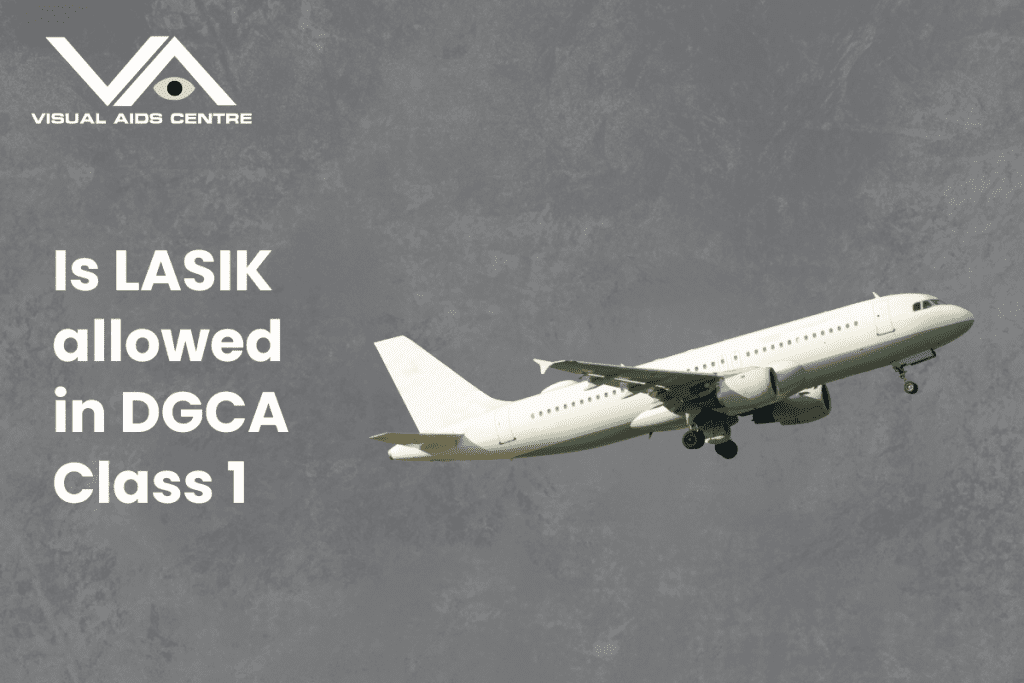Table of Contents
ToggleYes, LASIK is allowed for DGCA Class 1 medical certification, but there are specific guidelines and requirements that must be met to ensure you are medically fit to fly.
Here’s a detailed overview to guide pilots, aviation aspirants, and enthusiasts through the process.

Understanding DGCA’s Vision Standards
The Directorate General of Civil Aviation (DGCA) in India has established strict medical requirements for pilots, and vision is a critical aspect of these standards. Pilots must meet the following vision criteria for Class 1 medical certification:
- Visual Acuity
- Distant Visual Acuity (with or without correction):
- 6/9 or better for each eye separately.
- 6/6 or better for both eyes together (binocular visual acuity).
- Near Visual Acuity (with or without correction):
- N5 at 30–50 cms.
- N14 at 100 cms.
- Distant Visual Acuity (with or without correction):
- Corrective Lenses: If glasses or contact lenses are used, vision must still be correctable to 6/6.
- External Eye Examination: This includes an examination of the external eye and a detailed ophthalmoscopy. The cornea, in particular, is scrutinised to detect scarring or any surgical corrective procedures such as PRK or LASIK.
For aspiring pilots needing corrective vision, the DGCA allows LASIK surgery under defined guidelines.
When Can LASIK Be Considered?
LASIK is often recommended for those whose vision cannot be corrected to 6/6, even with glasses. It is commonly used to treat myopia, hyperopia, and astigmatism. However, there are important considerations before undergoing the procedure:
LASIK Eligibility for Pilots
- High Myopia: Candidates with severe myopia that glasses or contact lenses cannot correct may opt for LASIK. Consult an ophthalmologist for their expert recommendation.
- Corneal Thickness: The procedure reduces corneal thickness slightly. This thickness must stay above certain thresholds as specified on the DGCA website under their medical guidelines.
Once the surgery is conducted:
- Cooling Period: A mandatory six-month period post-surgery, referred to as the “cooling period”, is required. Pilots cannot undergo DGCA medical exams or fly during this time.
- Post-Surgery Medical Fitness: Candidates must meet the DGCA’s visual requirements after LASIK, along with additional conditions to be deemed fit for flying.
Post-Surgery Requirements for DGCA Class 1 Medical
If you’ve undergone LASIK surgery, specific medical checks must be satisfied to obtain medical fitness. Here’s what the DGCA mandates:
- Minimum Waiting Time: You must wait at least six months after the procedure before being considered for evaluation.
- Documentation of Recovery: Submit detailed documentation showing complete recovery and stable visual acuity to your designated medical examiner (AME).
- Corneal Topography: Corneal health should be normal. Complications such as corneal scarring or abnormalities impacting vision would disqualify a candidate.
- Stable Refraction: No significant changes in vision should occur during this period. Unstable refraction would require reevaluation.
What Medical Examinations Are Conducted Post-LASIK?
To assess medical fitness after LASIK, the following examinations will be performed:
- External Eye Examination and Ophthalmoscopy: Particular attention to any surgical scars or abnormalities on the cornea.
- Fundoscopy for High Myopes: High myopic individuals may undergo fundoscopy to ensure the absence of retinal issues such as lattice degeneration.
- Visual Acuity Tests: Compliance with distant (6/9 or 6/6) and near visual acuity (N5 and N14) standards must be met with or without corrective lenses.
Subsequent reviews or reevaluations will only take place at DGCA-authorised centres such as IAM or AFCME.
Requirements Post-LASIK
A minimum period of six months must have lapsed after the procedure, with eyes being free from any associated complications, as detailed below:
- Over or Under-treatment: There should be no requirement for repeat surgery or reliance on glasses/contact lenses due to overcorrection or undercorrection.
- Contrast Sensitivity: Visual contrast sensitivity must meet acceptable standards, ensuring no blurriness or washed-out vision.
- Corneal Health: The cornea must be free from scarring, warping, or any irregularities that could affect visual clarity.
- Flap Integrity: The surgical flap must be fully healed, with no related complications during or after the procedure.
- Dry Eyes: There should be no persistent dryness or discomfort affecting vision or overall eye health.
It is essential to consult a qualified ophthalmologist to confirm medical fitness and ensure that all post-LASIK requirements are met.
LASIK and Medical Certification for DGCA Licenses
Here’s a breakdown of how LASIK fits into DGCA medical certifications:
- Initial Certification Post-Surgery:
- Pilots applying for an initial Class 1 medical fitness certificate after LASIK surgery may be considered if they meet the visual and medical criteria, as discussed above.
- The absence of complications like corneal opacity or unstable refraction is mandatory.
- Periodic Reviews:
- To maintain a DGCA Class 1 medical certificate, pilots who have undergone LASIK will face periodic reviews carried out at DGCA-approved centres like IAM or AFCME. The process ensures continued compliance with visual acuity standards.
- Refractive Surgery Cases:
- The DGCA reviews cases involving LASIK or other refractive surgeries individually, approving candidates only when they meet all the required conditions.
Steps to Take for DGCA Certification Post-LASIK
If LASIK is essential to correct your vision for aviation purposes, here’s how to move forward:
- Conduct the Procedure:
- Choose a trusted and NABL/NABH-accredited diagnostic centre.
- Ensure all relevant sections of the CA35 form (medical examination form) are filled by the eye and ENT doctors.
- Adhere to the Cooling Period:
- Wait six months post-surgery before appearing for any DGCA medical exams.
- Post-Surgery Tests:
- Undergo examinations to ensure that your cornea remains healthy, there are no post-surgery complications, and your visual acuity is within the required limits.
- Submit Documentation:
- Provide evidence of your successful recovery and stable vision to your medical examiner.
- Take the Class 2 and Class 1 Medical Exams:
- For commercial pilot aspirants, begin with the Class 2 medical exam followed by the Class 1 medical exam after the cooling-off period.
Conclusion
LASIK is permissible for DGCA Class 1 certification. However, pilots must meet stringent guidelines to ensure they’re fit to fly. From achieving 6/6 visual acuity post-surgery to providing recovery documentation and undergoing thorough medical evaluations, the process is comprehensive.
If you’re considering LASIK to meet DGCA visual requirements, do so under the guidance of a trusted ophthalmologist. Remember, the procedure isn’t just about correcting your vision—it’s about fulfilling your dream of piloting while ensuring complete safety and compliance.
Fly high, see clearly!









